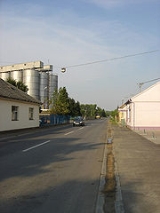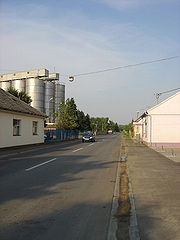
Beli Manastir
Encyclopedia
Beli Manastir is a town and municipality in eastern Croatia
, the principal town of the Croatian part of Baranja, in the Osijek-Baranja county
.
and primarily in Serbian
(its name "Beli manastir" as opposed to standard Croatian "Bijeli samostan" reflects the local speech of the Slavic-language population rather than adhering to specific Croatian or Serbian guidelines). This name was introduced in 1923 during the Kingdom of Serbs, Croats and Slovenes, and before this it was known as Monoštor in Croatian and Serbian. It was also known as Pélmonostor in Hungarian
and Manoster in German
.
Other names used for the town in history were: Pél, Bell, and Monostor. All names are connected with monasteries that existed in history at this location. First monastery was built in the 9th century during the rule of Slavic duke Kocelj. Monastery was later razed, and the only thing that left from it was pil (obelisk in English), hence the later Hungarian name Pél, which was a version of this Slavic word.
 The town was first mentioned in 1212 under name Pél. It has had very diverse ethnic composition since its earliest times. The population of the town through the history included Croats
The town was first mentioned in 1212 under name Pél. It has had very diverse ethnic composition since its earliest times. The population of the town through the history included Croats
, Serbs
, Magyars, Germans
and Roma.
According to the 1910 census, the town had 2,447 inhabitants, of which 1,496 (61.1%) were Germans
, 478 (19.5%) Serbs
and 443 (18.1%) Magyars.
In 1929 the population was made of: Magyars (33.8%), Germans
(32.6%), Croats
(18.8%) and Serbs
(around 12%).
During the Croatian War of Independence
, Beli Manastir was incorporated along with other towns into the unrecognized breakaway Republic of Serbian Krajina
. It was returned to Croatian control after the war.
Ethnic composition of Beli Manastir municipality by 2001 census was:
Croatia
Croatia , officially the Republic of Croatia , is a unitary democratic parliamentary republic in Europe at the crossroads of the Mitteleuropa, the Balkans, and the Mediterranean. Its capital and largest city is Zagreb. The country is divided into 20 counties and the city of Zagreb. Croatia covers ...
, the principal town of the Croatian part of Baranja, in the Osijek-Baranja county
Osijek-Baranja County
Osijek-Baranja county is a county in Croatia, located in northeastern Slavonia and Baranja. Its center is Osijek; other cities include Đakovo, Našice, Valpovo, Belišće, Beli Manastir.-Administrative divisions:Osijek-Baranja county is divided into:...
.
Name
The name means "white monastery" in CroatianCroatian language
Croatian is the collective name for the standard language and dialects spoken by Croats, principally in Croatia, Bosnia and Herzegovina, the Serbian province of Vojvodina and other neighbouring countries...
and primarily in Serbian
Serbian language
Serbian is a form of Serbo-Croatian, a South Slavic language, spoken by Serbs in Serbia, Bosnia and Herzegovina, Montenegro, Croatia and neighbouring countries....
(its name "Beli manastir" as opposed to standard Croatian "Bijeli samostan" reflects the local speech of the Slavic-language population rather than adhering to specific Croatian or Serbian guidelines). This name was introduced in 1923 during the Kingdom of Serbs, Croats and Slovenes, and before this it was known as Monoštor in Croatian and Serbian. It was also known as Pélmonostor in Hungarian
Hungarian language
Hungarian is a Uralic language, part of the Ugric group. With some 14 million speakers, it is one of the most widely spoken non-Indo-European languages in Europe....
and Manoster in German
German language
German is a West Germanic language, related to and classified alongside English and Dutch. With an estimated 90 – 98 million native speakers, German is one of the world's major languages and is the most widely-spoken first language in the European Union....
.
Other names used for the town in history were: Pél, Bell, and Monostor. All names are connected with monasteries that existed in history at this location. First monastery was built in the 9th century during the rule of Slavic duke Kocelj. Monastery was later razed, and the only thing that left from it was pil (obelisk in English), hence the later Hungarian name Pél, which was a version of this Slavic word.
History

Croats
Croats are a South Slavic ethnic group mostly living in Croatia, Bosnia and Herzegovina and nearby countries. There are around 4 million Croats living inside Croatia and up to 4.5 million throughout the rest of the world. Responding to political, social and economic pressure, many Croats have...
, Serbs
Serbs
The Serbs are a South Slavic ethnic group of the Balkans and southern Central Europe. Serbs are located mainly in Serbia, Montenegro and Bosnia and Herzegovina, and form a sizable minority in Croatia, the Republic of Macedonia and Slovenia. Likewise, Serbs are an officially recognized minority in...
, Magyars, Germans
Germans
The Germans are a Germanic ethnic group native to Central Europe. The English term Germans has referred to the German-speaking population of the Holy Roman Empire since the Late Middle Ages....
and Roma.
According to the 1910 census, the town had 2,447 inhabitants, of which 1,496 (61.1%) were Germans
Germans
The Germans are a Germanic ethnic group native to Central Europe. The English term Germans has referred to the German-speaking population of the Holy Roman Empire since the Late Middle Ages....
, 478 (19.5%) Serbs
Serbs
The Serbs are a South Slavic ethnic group of the Balkans and southern Central Europe. Serbs are located mainly in Serbia, Montenegro and Bosnia and Herzegovina, and form a sizable minority in Croatia, the Republic of Macedonia and Slovenia. Likewise, Serbs are an officially recognized minority in...
and 443 (18.1%) Magyars.
In 1929 the population was made of: Magyars (33.8%), Germans
Germans
The Germans are a Germanic ethnic group native to Central Europe. The English term Germans has referred to the German-speaking population of the Holy Roman Empire since the Late Middle Ages....
(32.6%), Croats
Croats
Croats are a South Slavic ethnic group mostly living in Croatia, Bosnia and Herzegovina and nearby countries. There are around 4 million Croats living inside Croatia and up to 4.5 million throughout the rest of the world. Responding to political, social and economic pressure, many Croats have...
(18.8%) and Serbs
Serbs
The Serbs are a South Slavic ethnic group of the Balkans and southern Central Europe. Serbs are located mainly in Serbia, Montenegro and Bosnia and Herzegovina, and form a sizable minority in Croatia, the Republic of Macedonia and Slovenia. Likewise, Serbs are an officially recognized minority in...
(around 12%).
During the Croatian War of Independence
Croatian War of Independence
The Croatian War of Independence was fought from 1991 to 1995 between forces loyal to the government of Croatia—which had declared independence from the Socialist Federal Republic of Yugoslavia —and the Serb-controlled Yugoslav People's Army and local Serb forces, with the JNA ending its combat...
, Beli Manastir was incorporated along with other towns into the unrecognized breakaway Republic of Serbian Krajina
Republic of Serbian Krajina
The Republic of Serbian Krajina was a self-proclaimed Serb entity within Croatia. Established in 1991, it was not recognized internationally. It formally existed from 1991 to 1995, having been initiated a year earlier via smaller separatist regions. The name Krajina means "frontier"...
. It was returned to Croatian control after the war.
Geography
The municipality of Beli Manastir is composed of 4 settlements:- Beli Manastir, population 8,034
- Branjin VrhBranjin VrhBranjin Vrh is a settlement in the region of Baranja, Croatia. Administratively, it is located in the Beli Manastir municipality within the Osijek-Baranja County.-See also:*Osijek-Baranja county*Baranja...
, population 982, formerly called Baranyavár - ŠećeranaŠecerana, Beli ManastirŠećerana is a settlement in the region of Baranja, Croatia. Administratively, it is located in the Beli Manastir municipality within the Osijek-Baranja County.-See also:*Osijek-Baranja county*Baranja...
, population 536 - ŠumarinaŠumarinaŠumarina is a settlement in the region of Baranja, Croatia. Administratively, it is located in the Beli Manastir municipality within the Osijek-Baranja County.-See also:*Osijek-Baranja county*Baranja...
, population 481
2001
The town has a population of 8,671 (2001), while total municipality population is 10,986.Ethnic composition of Beli Manastir municipality by 2001 census was:
- CroatsCroatsCroats are a South Slavic ethnic group mostly living in Croatia, Bosnia and Herzegovina and nearby countries. There are around 4 million Croats living inside Croatia and up to 4.5 million throughout the rest of the world. Responding to political, social and economic pressure, many Croats have...
= 6,085 (55.39%) - SerbsSerbsThe Serbs are a South Slavic ethnic group of the Balkans and southern Central Europe. Serbs are located mainly in Serbia, Montenegro and Bosnia and Herzegovina, and form a sizable minority in Croatia, the Republic of Macedonia and Slovenia. Likewise, Serbs are an officially recognized minority in...
= 2,920 (26.58%) - Hungarians = 933 (8.49%)
- Roma = 153 (1.39%)
- GermansGermansThe Germans are a Germanic ethnic group native to Central Europe. The English term Germans has referred to the German-speaking population of the Holy Roman Empire since the Late Middle Ages....
= 122 (1.11%)

